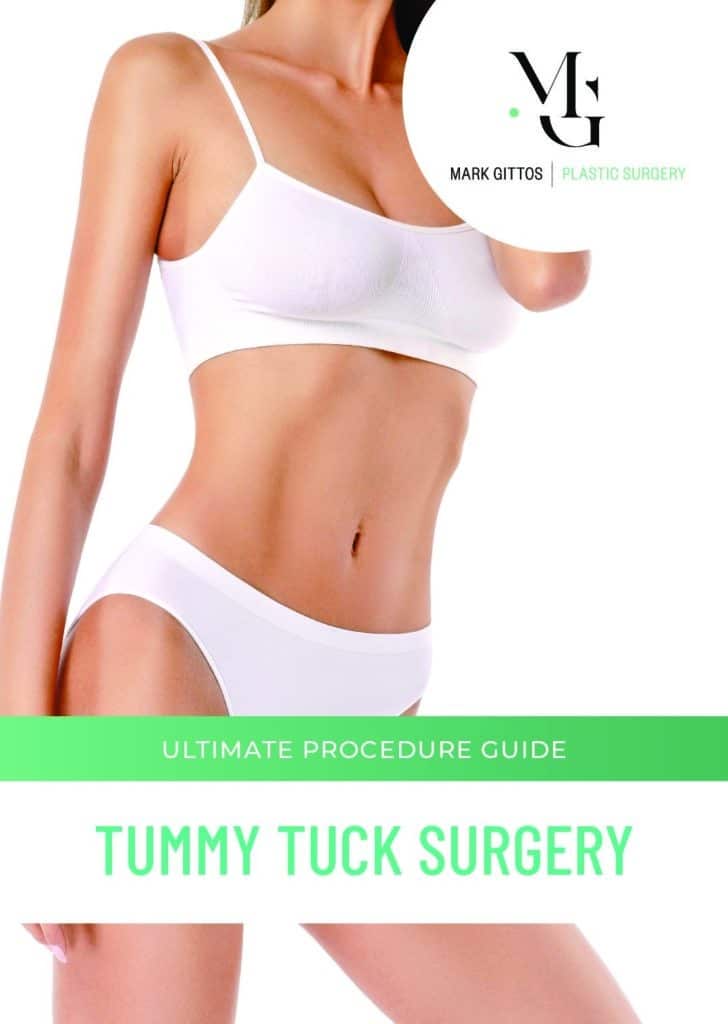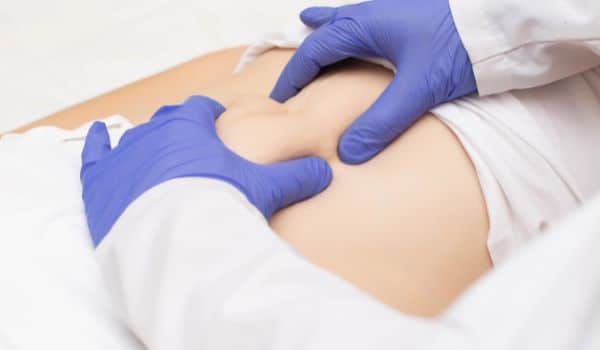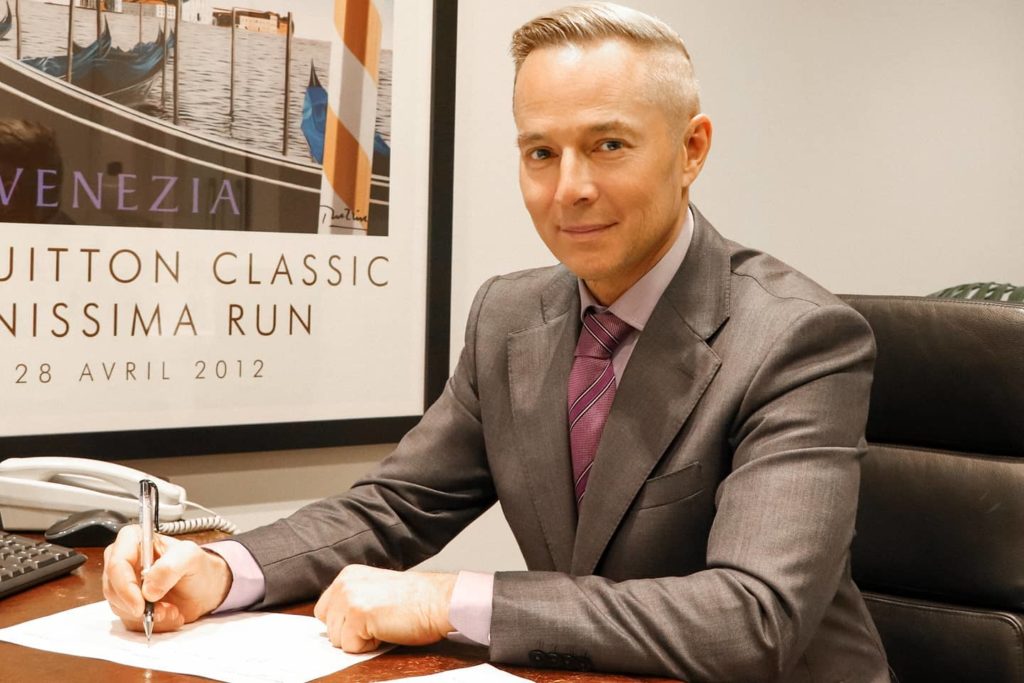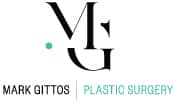Can I Combine Hernia Repair Surgery with a Tummy Tuck?
The surgical repair of a hernia can be performed by a plastic surgeon to ensure the best aesthetic and functional results. Abdominal hernias, such as umbilical and midline hernias, develop when part of the intestines or fat pushes through weakened abdominal muscles. The muscles of the abdomen can become vulnerable to a hernia because of a previous pregnancy or being overweight.
Hernia repair surgery can also be combined with a full tummy tuck including diastasis recti repair (Split tummy muscles) to further strengthen the abdominal muscles and give the belly a flatter and smoother appearance.
Dr Mark Gittos is a specialist plastic surgeon and a body contouring expert with extensive training in abdominal wall reconstruction and rectus diastasis repair. He uses fine surgical approaches and advanced suturing techniques to give his patients the most appealing cosmetic results after fixing their hernia.
Download Dr Gittos’ Guide to Tummy Tuck Surgery in NZ

What is a Hernia?
A hernia is a condition that occurs when part of your internal body tissue, such as intestines or fat, pushes through an opening or a weak spot in the muscle or surrounding tissue wall. A hernia usually develops as a lump in the tummy or the groin area that appears when you cough, cry, or strain and becomes less obvious when you’re lying down.
Hernias can develop in both children and adults. In most cases, hernias in children don’t cause any symptoms except for a painless bulge. On the other hand, symptoms of hernia in adults include:
- A noticeable bulge or lump that goes away when you lie down
- The site of the hernia may become swollen, tender, or discoloured
- Pain or discomfort around the hernia
- Having trouble defecating (pooping) or passing wind
- Symptoms that worsen when you stand up or strain yourself
- Vomiting
Hernias are usually treated by a general surgeon or a plastic surgeon. Dr Mark Gittos usually treats belly hernias as a part of a larger cosmetic procedure (e.g. Tummy tuck). Nevertheless, hernia surgery can be performed as a standalone procedure by a plastic surgeon if you’re looking to maximise the cosmetic outcomes.
What Are the Different Types Of Hernias?
Different types of hernias can develop in the abdomen and groin. The hernia type depends on the location where the swelling or lump appears.
Different Types of hernia include:
- Ventral Hernia – occur in the abdomen when abdominal tissue or an organ (such as an intestine) protrudes through a cavity muscle area.- Types of Ventral Hernias include epigastric, umbilical or incisional.
- Umbilical hernia: this abdominal hernia type occurs when part of your intestines pushes through a weakness or an opening in the muscles of your tummy near your umbilicus (belly button)
- Femoral and inguinal hernia: these types of hernia appear when part of the bowels herniates downward, causing a bulge in the groin area
- Epigastric hernia: also known as midline hernias, epigastric hernias occur when fatty tissues bulge through your tummy in the area between your belly and the lower part of your sternum (breastbone)
- Diastasis recti: this is a type of hernia that commonly develops as a consequence of pregnancy. The stretched abdominal muscles (abs) become separated at the midline, allowing fat or intestines to bulge through the gap
- Incisional or Surgical wound hernia: any surgical wound in the abdomen is prone to herniate. The sutured tissue is weaker than normal tissue, which increases the lifetime risk of a hernia developing through the old wound
What Causes a Hernia?

Abdominal hernias in adults are mainly caused by increased strain or pressure on the tummy combined with a weakness in the abdominal muscles.
Causes of increased abdominal pressure in adults include:
- Obesity or being overweight
- A persistent heavy cough
- Multiple pregnancies (twins or triplets)
- Straining too much while you are moving or lifting heavy objects
The exact cause of umbilical and epigastric hernias in adults is hard to determine. Although, the primary risk factors for most abdominal hernias are previous pregnancy and being overweight.
During or after pregnancy, women may develop a condition known as diastasis recti, also known as diastasis rectus abdominis. This is a commonly observed condition in women having a tummy tuck procedure to enhance the look of their tummy.
The rectus abdominis muscles are vertical muscles that run along the front of your stomach and are known as “six-pack abs”. During pregnancy, the abdomen becomes stretched creating a gap between the abdominal muscles. After delivery, these muscles heal and retract back closer together.
Diastasis rectus occurs when the overstretched muscles lose their elasticity and are unable to come back together and close the gap properly. A permanent gap develops in the abdominal wall until it’s repaired with the help of an abdominoplasty (tummy tuck).
An umbilical or midline hernia, on the other hand, can develop when fatty tissue or part of the bowels push through these weakened abdominal muscles into an area near the navel. This is also a commonly treated hernia during tummy tuck surgery.
What Are the Complications Of Hernia?
Complications from an epigastric or umbilical hernia can occur if:
- Part of the bulging bowel becomes trapped outside the stomach and can no longer be pushed back in. This can cause nausea, vomiting, and abdominal pain
- A section of the protruding bowels becomes stuck and cut off from its blood supply. This can lead to the suffocation of the tissue and eventually tissue death. Consequently, an infection can spread through the abdomen and become life-threatening
To avoid or fix possible hernia complications, hernia repair surgery is recommended for most adults with hernias because they’re unlikely to resolve on their own. If Dr Gittos finds an undiagnosed hernia during your tummy tuck, he would repair it to avoid future complications. This will, of course, be discussed with Dr Gittos before your abdominoplasty.
Getting a Tummy Tuck with your Hernia Repair Surgery
Surgery done to repair an umbilical or midline hernia involves the strengthening and tightening of the muscles of the abdomen similar to a tummy tuck. A full tummy tuck tones and slims your abdomen by removing excess skin and fat and strengthening your abdominal muscles. Therefore, Dr Gittos can correct an umbilical or epigastric hernia as a part of your abdominoplasty.
In some cases, the hernia is there but it’s not apparent because it’s hidden by the layers of extra fat and skin. During a tummy tuck surgery, the hernia may only become obvious after Dr Gittos removes the excess tissue surrounding it.
This is why you should choose an plastic surgeon with experience in performing both a tummy tuck and a hernia repair at the same time. Dr Gittos will push the protruding hernia back behind the abdominal wall and repair the rectus diastasis before tightening and smoothing the rest of your belly.
Types of Hernia Repair Surgery

Umbilical and midline hernias require surgical repair to push the herniated lump back in place and strengthen the abdominal muscles.
Hernia repair can be done on its own by an open hernia surgery or laparoscopic hernia surgery. It can also be combined with a full abdominoplasty to improve both the cosmetic appearance of the abdomen and restore the functionality of the abdominal wall.
1. Open Hernia Surgery
The incision for your hernia correction surgery will depend on the location of your hernia.
During an epigastric or umbilical open hernia repair, Dr Gittos will perform the following:
- First, he will make a small cut at the base of the belly button or above it (depending on the site of the hernia)
- Then, he will push the protruding intestine or fatty lump back into the stomach
- After that, he will repair the weakened abdominal muscles by stitching them together and strengthening them. If the hernia is large, Dr Gittos will use a special mesh patch instead to strengthen the abdominal wall and correct your diastasis rectus abdominis.
- Finally, Dr Gittos will use dissolvable stitches and delicate suturing techniques to close your wounds
An open hernia surgery performed on its own takes around 30 minutes and it’s usually done under general anaesthesia – you’ll be asleep and won’t feel any pain during your hernia surgery.
2. Combined Tummy Tuck and Hernia Repair Surgery
Dr Gittos can also fix your split tummy muscles (rectus diastasis) as part of your full tummy tuck surgery. A combined tummy tuck and hernia repair surgery will start the same as a traditional abdominoplasty:
- First, Dr Gittos will make a precise horizontal incision along your bikini line that extends from hip bone to hip bone. He strategically places the incision low down your abdomen so it can be easily covered with a bikini or underwear
- After this he will carefully detach the abdominal skin from the umbilicus and separate the skin and fat from the deeper muscle layer of the stomach. Then, he will lift the skin all the way up to the breastbone
- Dr Gittos will push back the bulging hernia into its place and repair your rectus diastasis with strong sutures that bring your deep abdominal muscles and connective tissue together. This will fix the muscle laxity in your abs and improve the contour of your abdominal muscles
- Afterward, sagging skin and fat will be pulled down firmly to flatten and smooth the tummy and the excess tissue is cut out
- Lastly, Dr Gittos will use special suturing techniques to close your wounds and minimise scarring
A hernia repair surgery combined with an abdominoplasty takes around two to two and a half hours on average and is done under general anaesthesia.
3. Laparoscopic Hernia Surgery without a Tummy tuck(not offered by Dr Gittos)
During a laparoscopic hernia repair, Your Surgeon makes several but smaller incisions near your navel that allow him to access and repair your hernia. After making the incisions:
- Your surgeon will insert a laparoscope (a thin tube with a camera attached to it) through the incisions
- Your abdomen is then inflated with a harmless carbon dioxide gas that will make space and allow your surgeon to view and fix your hernia
- The contents of your hernia are pushed back into the abdomen
- A special patch of mesh is then sutured to the supporting tissue surrounding the hernia to close and strengthen the abdominal wall.
A laparoscopic surgery done to fix your hernia is minimally invasive and leaves almost invisible scars.
Why Should I Choose a Plastic Surgeon For My Hernia Repair ?

An abdominal hernia could be performed by a General Surgeon. However, a plastic surgeon can offer a more reconstructive approach that can correct even complex hernia cases.
The expertise of skilled plastic surgeons, such as Dr Mark Gittos, can offer you the following benefits while repairing your hernia:
- More delicate incisions
- Aesthetic suturing techniques
- Less scarring
- More cosmetically appealing results
Moreover, only a plastic surgeon can perform a tummy tuck and a hernia repair at the same time. Combining an abdominoplasty with hernia repair can offer you the following advantages:
- You’ll get a cosmetic and functional repair of your abdomen
- You’ll have to undergo only one anaesthesia and one recovery time
- Your plastic surgeon can address diastasis recti, a bulging hernia, loose belly skin, and excess fat in the abdomen all at the same time
Whether done alone or as part of an abdominoplasty, a hernia repair surgery performed by a plastic surgeon can give you more aesthetically appealing cosmetic results and less visible scars.
Funding your Hernia Repair Surgery and Tummy Tuck
During your consultation, Dr Mark Gittos will fully assess your condition and his team will discuss with you possible financing options for your surgery.
FAQs about Hernia Repair Surgery

Is it normal to have a lump after hernia repair surgery?
- It’s not uncommon to experience some swelling and fluid accumulation after any surgery, including a hernia repair surgery. This can sometimes feel like a lump. With time, the swelling will go down as you recover and you’ll feel the lump getting smaller every day.
What are the symptoms of a failed hernia repair?
- The signs of hernia repair failure include severe pain that does not subside over time or with prescribed pain meds, fever, and tenderness around the incision site, vomiting, and constipation. You must choose a highly skilled surgeon to perform your hernia repair surgery who can foresee and avoid possible complications from your hernia repair surgery.
Can I have liposuction during hernia repair?
You might be able to get liposuction at the same time as your hernia repair surgery. Your plastic surgeon will assess the size of your hernia and the area of your abdomen that requires fat removal before making that decision.
Do hernias need to be repaired immediately?
- Although small hernias that don’t cause any pain or problems do not need immediate surgery, in most cases, hernias in adults get larger with time and might eventually cause serious health problems. Thus, surgery to repair a hernia is usually recommended for adults.
What is the best way to repair a hernia?
- Hernias are usually treated with surgery. Hernia repair can be done on its own by laparoscopic surgery or open repair surgery. It can also be done at the same time as a tummy tuck surgery to improve both the function and appearance of the abdominal wall and muscles.
Further Reading about different Tummy Tuck Surgery with Dr Gittos
Medical References about Hernia Repair Surgery
- Hernias – Surgical Treatment – NCBI Bookshelf
- Umbilical Hernia – StatPearls – NCBI Bookshelf
- A systematic review on surgical treatment of primary epigastric hernias – PMC
- Diastasis Recti Rehabilitation – StatPearls – NCBI Bookshelf
- Abdominoplasty repair for abdominal wall hernias
About Dr Mark Gittos FRACS (Plast) – New Zealand Plastic Surgeon
Practice locations in Herne Bay Auckland, Northland and Bay of Plenty – Kerikeri, Whangarei, New Plymouth & Tauranga
Dr Mark Gittos is a leading Specialist Plastic Surgeon and operates a practice in Herne Bay, Auckland and in the UK. The practice focuses on both surgical and non-surgical procedures, each designed to help restore, improve or change a physical characteristic or problem. The first step in every case is to talk through your personal requirements and explore all the options, before deciding on the most effective solution.
Dr Mark Gittos offers high quality, natural-looking cosmetic surgery results and is highly experienced in Breast, Body and Face Surgery having performed over 4000 Surgeries in the last 26 years. With worldwide expertise Dr Gittos is an expert in breast, face and body surgery for men & women.
Naturally, before any treatment is begun, we will explain clearly the advantages and risk factors; so that you have the information you need to make an informed decision that is best for you. Visit the practice to find out more.

NEXT STEPS
Please NOTE: Dr Gittos only performs surgery on non-smoker patients with a BMI less than 30. To check your BMI please visit the NZ Heart Foundation website. For help giving up smoking before surgery visit the Smoke Free website
Do your Research
- Read the Website and Blogs relevant to your procedure
- Browse our Frequently Asked Questions including how to choose a Surgeon for your procedure
- Download and read the FREE Guides to Surgery
What to Bring to your Plastic Surgeon Consultation
- Bring a friend or relative to help discuss the information and your choices
- Take lots of notes and read the documents provided thoroughly
- Dress in simple clothes as you may need to undress for examination
- Bring your medical referral and any relevant medical documents or test results
Book your Initial Surgery Consultation
- A Referral from your GP or specialist is helpful but NOT essential – you can have a consultation without a GP Referral
- Email us or Call on 09 529 5352 to arrange your surgeon consultation appointment.
- Book a consultation with Dr Gittos by paying the Consultation Fee – $325 incl GST
Traveling for Surgery? – Consider post-surgery luxury recovery in a Hotel with LuxeCare
Please contact us to arrange to book a consultation with our Specialist Plastic Surgeon or to speak with our Patient Care Advisor.
Send an enquiry form today or phone 09 529 5352 during Clinic Hours
